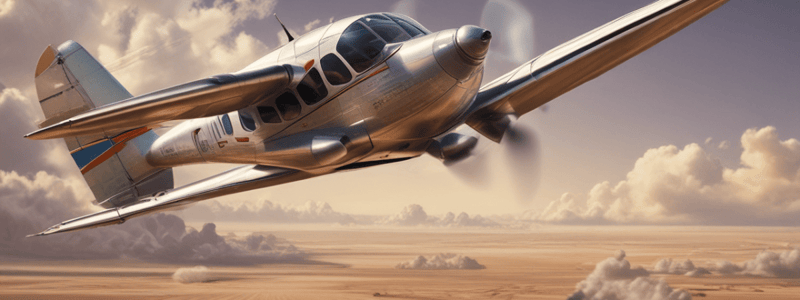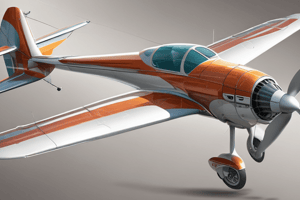Podcast
Questions and Answers
What is the primary function of an aircraft's wing?
What is the primary function of an aircraft's wing?
- To provide stability
- To reduce drag
- To generate thrust
- To generate lift (correct)
What type of wing is commonly found on light aircraft?
What type of wing is commonly found on light aircraft?
- Straight wing (correct)
- High aspect ratio wing
- Swept wing
- Delta wing
What is the primary advantage of swept wings on commercial jet airliners?
What is the primary advantage of swept wings on commercial jet airliners?
- Reduced weight
- Improved stability
- Increased lift
- Delayed onset of shock waves (correct)
What type of wing provides a blend of high lift and high-speed capabilities?
What type of wing provides a blend of high lift and high-speed capabilities?
What is the primary effect of a high aspect ratio wing on an aircraft's performance?
What is the primary effect of a high aspect ratio wing on an aircraft's performance?
What is the primary advantage of low aspect ratio wings on fighter jets?
What is the primary advantage of low aspect ratio wings on fighter jets?
What is the primary consideration for engineers designing an aircraft's wing?
What is the primary consideration for engineers designing an aircraft's wing?
What is the primary benefit of applying aerodynamics in aircraft design?
What is the primary benefit of applying aerodynamics in aircraft design?
What is the relationship between the length and width of a wing known as?
What is the relationship between the length and width of a wing known as?
What is the primary purpose of a wing's design in an aircraft?
What is the primary purpose of a wing's design in an aircraft?
The shape of a wing affects the drag forces that act upon the aircraft.
The shape of a wing affects the drag forces that act upon the aircraft.
Delta wings are commonly found on commercial jet airliners.
Delta wings are commonly found on commercial jet airliners.
High aspect ratio wings are suitable for fighter jets.
High aspect ratio wings are suitable for fighter jets.
The efficiency of a wing is influenced by its propeller characteristics.
The efficiency of a wing is influenced by its propeller characteristics.
Swept wings are characterized by their forward angle.
Swept wings are characterized by their forward angle.
Wing design is crucial to the fuel efficiency of an aircraft.
Wing design is crucial to the fuel efficiency of an aircraft.
Low aspect ratio wings are suitable for gliders.
Low aspect ratio wings are suitable for gliders.
The shape of a wing affects the stability of an aircraft.
The shape of a wing affects the stability of an aircraft.
Aircraft with high-speed capabilities typically have straight wings.
Aircraft with high-speed capabilities typically have straight wings.
Engineers must consider the specific performance requirements of an aircraft to determine the most appropriate propeller characteristics.
Engineers must consider the specific performance requirements of an aircraft to determine the most appropriate propeller characteristics.
What is the primary advantage of using a wing design with a high aspect ratio in a glider?
What is the primary advantage of using a wing design with a high aspect ratio in a glider?
How do delta wings differ from other wing designs in terms of their aerodynamic properties?
How do delta wings differ from other wing designs in terms of their aerodynamic properties?
What is the primary reason why engineers must consider the specific performance requirements of an aircraft when designing its wing?
What is the primary reason why engineers must consider the specific performance requirements of an aircraft when designing its wing?
How does the rearward angle of a swept wing affect its performance?
How does the rearward angle of a swept wing affect its performance?
What is the primary advantage of using a wing design with a low aspect ratio in a fighter jet?
What is the primary advantage of using a wing design with a low aspect ratio in a fighter jet?
How do the design of an aircraft's wing and propeller affect its overall performance?
How do the design of an aircraft's wing and propeller affect its overall performance?
What is the primary effect of the wing's shape on the drag forces that act upon the aircraft?
What is the primary effect of the wing's shape on the drag forces that act upon the aircraft?
How does the design of an aircraft's wing affect its stability?
How does the design of an aircraft's wing affect its stability?
What is the primary advantage of using a straight wing design in a light aircraft?
What is the primary advantage of using a straight wing design in a light aircraft?
How does the application of aerodynamics in aircraft design impact its overall performance?
How does the application of aerodynamics in aircraft design impact its overall performance?
Flashcards are hidden until you start studying
Study Notes
Propeller Design
- Propellers are crucial for an aircraft's efficiency and thrust, converting engine power into aerodynamic force.
- A propeller works by slicing through the air at a precise angle, creating a difference in air pressure that propels the aircraft forward.
- The main components of a propeller are the blades and the hub, with the blades being the airfoil sections that cut through the air and the hub being the central part that connects the blades and attaches to the engine shaft.
- The shape of a propeller blade is finely tuned to maximize efficiency, with a higher pitch (twist of the blades) increasing thrust but requiring more engine power.
- Propeller size and revolutions per minute (RPM) are crucial factors in aircraft performance design, with a larger propeller moving slowly producing the same amount of thrust as a smaller one moving quickly but with improved efficiency and less noise.
Wing Design
- The wings are the primary means of generating lift, and their design affects not only lift but also drag forces that act upon the aircraft.
- The shape of a wing is crucial, with camber (curvature) and cross-sectional shape affecting how air moves over and under the wing, creating lift via Bernoulli's principle.
- Different wing designs, such as straight, swept, or delta wings, each have unique aerodynamic properties that make them suitable for various flight regimes.
- Wing design considerations include aspect ratio, which is the wing's span divided by its average width, and wing loading, which is the weight of the airplane per area of the wing.
- Winglets, upturned ends on airplane wings, mitigate wingtip vortices, reducing drag and increasing lift.
- Modern wing manufacturing is shifting towards materials like carbon fiber composites, making wings lighter yet stronger and presenting a sustainable future in aviation.
Aerodynamics and Efficiency
- The design of propellers and wings is crucial to optimizing flight characteristics such as thrust, lift, and overall aerodynamic efficiency.
- Efficiency is paramount in aviation, with engineers considering specific performance requirements to determine the most appropriate wing shape and propeller characteristics.
- By understanding and applying aerodynamics, designers can create wings and propellers that enhance the aircraft's efficiency, reduce fuel consumption, and improve overall performance.
Propeller Design
- Propellers are crucial for an aircraft's efficiency and thrust, converting engine power into aerodynamic force.
- A propeller works by slicing through the air at a precise angle, creating a difference in air pressure that propels the aircraft forward.
- The main components of a propeller are the blades and the hub, with the blades being the airfoil sections that cut through the air and the hub being the central part that connects the blades and attaches to the engine shaft.
- The shape of a propeller blade is finely tuned to maximize efficiency, with a higher pitch (twist of the blades) increasing thrust but requiring more engine power.
- Propeller size and revolutions per minute (RPM) are crucial factors in aircraft performance design, with a larger propeller moving slowly producing the same amount of thrust as a smaller one moving quickly but with improved efficiency and less noise.
Wing Design
- The wings are the primary means of generating lift, and their design affects not only lift but also drag forces that act upon the aircraft.
- The shape of a wing is crucial, with camber (curvature) and cross-sectional shape affecting how air moves over and under the wing, creating lift via Bernoulli's principle.
- Different wing designs, such as straight, swept, or delta wings, each have unique aerodynamic properties that make them suitable for various flight regimes.
- Wing design considerations include aspect ratio, which is the wing's span divided by its average width, and wing loading, which is the weight of the airplane per area of the wing.
- Winglets, upturned ends on airplane wings, mitigate wingtip vortices, reducing drag and increasing lift.
- Modern wing manufacturing is shifting towards materials like carbon fiber composites, making wings lighter yet stronger and presenting a sustainable future in aviation.
Aerodynamics and Efficiency
- The design of propellers and wings is crucial to optimizing flight characteristics such as thrust, lift, and overall aerodynamic efficiency.
- Efficiency is paramount in aviation, with engineers considering specific performance requirements to determine the most appropriate wing shape and propeller characteristics.
- By understanding and applying aerodynamics, designers can create wings and propellers that enhance the aircraft's efficiency, reduce fuel consumption, and improve overall performance.
Propeller Design
- Propellers are crucial for an aircraft's efficiency and thrust, converting engine power into aerodynamic force.
- A propeller works by slicing through the air at a precise angle, creating a difference in air pressure that propels the aircraft forward.
- The main components of a propeller are the blades and the hub, with the blades being the airfoil sections that cut through the air and the hub being the central part that connects the blades and attaches to the engine shaft.
- The shape of a propeller blade is finely tuned to maximize efficiency, with a higher pitch (twist of the blades) increasing thrust but requiring more engine power.
- Propeller size and revolutions per minute (RPM) are crucial factors in aircraft performance design, with a larger propeller moving slowly producing the same amount of thrust as a smaller one moving quickly but with improved efficiency and less noise.
Wing Design
- The wings are the primary means of generating lift, and their design affects not only lift but also drag forces that act upon the aircraft.
- The shape of a wing is crucial, with camber (curvature) and cross-sectional shape affecting how air moves over and under the wing, creating lift via Bernoulli's principle.
- Different wing designs, such as straight, swept, or delta wings, each have unique aerodynamic properties that make them suitable for various flight regimes.
- Wing design considerations include aspect ratio, which is the wing's span divided by its average width, and wing loading, which is the weight of the airplane per area of the wing.
- Winglets, upturned ends on airplane wings, mitigate wingtip vortices, reducing drag and increasing lift.
- Modern wing manufacturing is shifting towards materials like carbon fiber composites, making wings lighter yet stronger and presenting a sustainable future in aviation.
Aerodynamics and Efficiency
- The design of propellers and wings is crucial to optimizing flight characteristics such as thrust, lift, and overall aerodynamic efficiency.
- Efficiency is paramount in aviation, with engineers considering specific performance requirements to determine the most appropriate wing shape and propeller characteristics.
- By understanding and applying aerodynamics, designers can create wings and propellers that enhance the aircraft's efficiency, reduce fuel consumption, and improve overall performance.
Studying That Suits You
Use AI to generate personalized quizzes and flashcards to suit your learning preferences.




